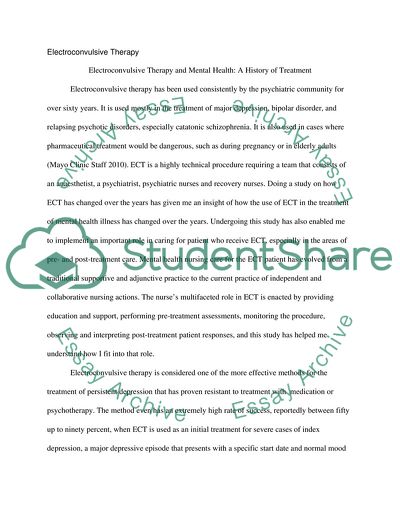Cite this document
(Electroconvulsive Therapy and Mental Health Case Study Example | Topics and Well Written Essays - 1250 words - 1, n.d.)
Electroconvulsive Therapy and Mental Health Case Study Example | Topics and Well Written Essays - 1250 words - 1. https://studentshare.org/physics/1750092-the-study-and-history-of-electroconvulsive-therapy-and-how-it-has-changed-over-the-years-its-presentpast-and-future-and-it-should-be-linked-to-my-future-role-or-practice-as-a-mental-nurse
Electroconvulsive Therapy and Mental Health Case Study Example | Topics and Well Written Essays - 1250 words - 1. https://studentshare.org/physics/1750092-the-study-and-history-of-electroconvulsive-therapy-and-how-it-has-changed-over-the-years-its-presentpast-and-future-and-it-should-be-linked-to-my-future-role-or-practice-as-a-mental-nurse
(Electroconvulsive Therapy and Mental Health Case Study Example | Topics and Well Written Essays - 1250 Words - 1)
Electroconvulsive Therapy and Mental Health Case Study Example | Topics and Well Written Essays - 1250 Words - 1. https://studentshare.org/physics/1750092-the-study-and-history-of-electroconvulsive-therapy-and-how-it-has-changed-over-the-years-its-presentpast-and-future-and-it-should-be-linked-to-my-future-role-or-practice-as-a-mental-nurse.
Electroconvulsive Therapy and Mental Health Case Study Example | Topics and Well Written Essays - 1250 Words - 1. https://studentshare.org/physics/1750092-the-study-and-history-of-electroconvulsive-therapy-and-how-it-has-changed-over-the-years-its-presentpast-and-future-and-it-should-be-linked-to-my-future-role-or-practice-as-a-mental-nurse.
“Electroconvulsive Therapy and Mental Health Case Study Example | Topics and Well Written Essays - 1250 Words - 1”. https://studentshare.org/physics/1750092-the-study-and-history-of-electroconvulsive-therapy-and-how-it-has-changed-over-the-years-its-presentpast-and-future-and-it-should-be-linked-to-my-future-role-or-practice-as-a-mental-nurse.


